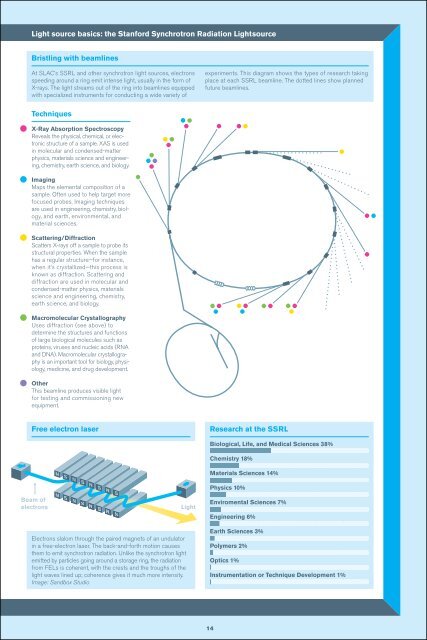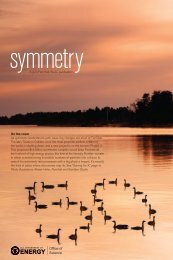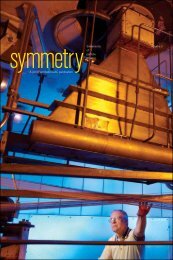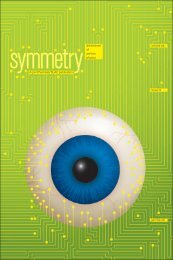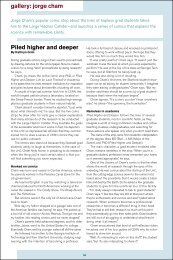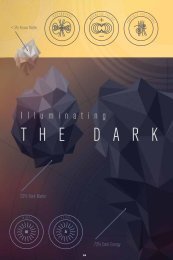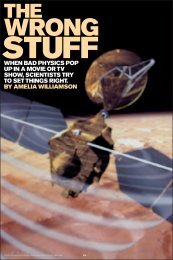pdf of the issue - Symmetry Magazine
pdf of the issue - Symmetry Magazine
pdf of the issue - Symmetry Magazine
Create successful ePaper yourself
Turn your PDF publications into a flip-book with our unique Google optimized e-Paper software.
Light source basics: <strong>the</strong> Stanford Synchrotron Radiation Lightsource<br />
Bristling with beamlines<br />
At SLAC’s SSRL and o<strong>the</strong>r synchrotron light sources, electrons<br />
speeding around a ring emit intense light, usually in <strong>the</strong> form <strong>of</strong><br />
X-rays. The light streams out <strong>of</strong> <strong>the</strong> ring into beamlines equipped<br />
with specialized instruments for conducting a wide variety <strong>of</strong><br />
Techniques<br />
X-Ray Absorption Spectroscopy<br />
Reveals <strong>the</strong> physical, chemical, or electronic<br />
structure <strong>of</strong> a sample. XAS is used<br />
in molecular and condensed-matter<br />
physics, materials science and engineering,<br />
chemistry, earth science, and biology.<br />
Imaging<br />
Maps <strong>the</strong> elemental composition <strong>of</strong> a<br />
sample. Often used to help target more<br />
focused probes. Imaging techniques<br />
are used in engineering, chemistry, biology,<br />
and earth, environmental, and<br />
material sciences.<br />
Scattering/Diffraction<br />
Scatters X-rays <strong>of</strong>f a sample to probe its<br />
structural properties. When <strong>the</strong> sample<br />
has a regular structure—for instance,<br />
when it’s crystallized—this process is<br />
known as diffraction. Scattering and<br />
diffraction are used in molecular and<br />
condensed-matter physics, materials<br />
science and engineering, chemistry,<br />
earth science, and biology.<br />
Macromolecular Crystallography<br />
Uses diffraction (see above) to<br />
determine <strong>the</strong> structures and functions<br />
<strong>of</strong> large biological molecules such as<br />
proteins, viruses and nucleic acids (RNA<br />
and DNA). Macromolecular crystallography<br />
is an important tool for biology, physiology,<br />
medicine, and drug development.<br />
O<strong>the</strong>r<br />
This beamline produces visible light<br />
for testing and commissioning new<br />
equipment.<br />
Free electron laser<br />
Beam <strong>of</strong><br />
electrons Light<br />
Electrons slalom through <strong>the</strong> paired magnets <strong>of</strong> an undulator<br />
in a free-electron laser. The back-and-forth motion causes<br />
<strong>the</strong>m to emit synchrotron radiation. Unlike <strong>the</strong> synchrotron light<br />
emitted by particles going around a storage ring, <strong>the</strong> radiation<br />
from FELs is coherent, with <strong>the</strong> crests and <strong>the</strong> troughs <strong>of</strong> <strong>the</strong><br />
light waves lined up; coherence gives it much more intensity.<br />
Image: Sandbox Studio<br />
experiments. This diagram shows <strong>the</strong> types <strong>of</strong> research taking<br />
place at each SSRL beamline. The dotted lines show planned<br />
future beamlines.<br />
Research at <strong>the</strong> SSRL<br />
Biological, Life, and Medical Sciences 38%<br />
Chemistry 18%<br />
Materials Sciences 14%<br />
Physics 10%<br />
Enviromental Sciences 7%<br />
Engineering 6%<br />
Earth Sciences 3%<br />
Polymers 2%<br />
Optics 1%<br />
Instrumentation or Technique Development 1%<br />
14


